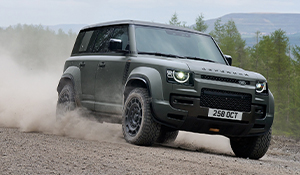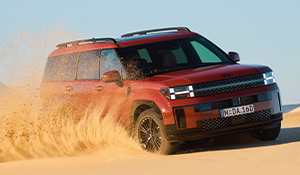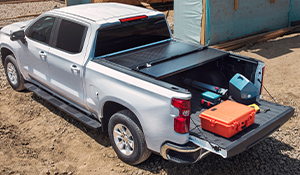How to: Steep Hill Climbs
Knowing your vehicle
As with any off-road scenario, having an intimate understanding of your vehicle and its features will be of great benefit when you’re confronted with a steep hill climb.
There are the obvious mechanical features, such as whether your vehicle has a manual or automatic transmission, and the not so obvious such as whether it has a live-axle or independent suspension, or a combination of the two types. Other factors that will have a significant bearing on how your vehicle will perform when climbing a steep hill include engine output, overall gearing, tyres, traction aids, ground clearance and wheel travel.
On particularly steep hill climbs, you’ll want all the torque and traction your vehicle can muster, so gear selection, correct tyre pressures and engagement of all available traction aids is critical.

Judging the terrain
Before you tackle a steep hill climb, it pays to know what’s ahead of you, and there are several factors to take into account when surveying a steep track. The obvious one: how steep is the hill? Other questions to ask yourself include: what is the track surface; how slippery is it; how deeply rutted is it; are there any obstacles; and is there somewhere safe to stop/turn-around if necessary?
In some cases all of this information can be gathered from the safety and comfort of the driver’s seat, but in others the only way to know what lies ahead is to get out and walk the track.

If you have to walk it, look out for potential obstacles on the way up, such as deep ruts, ditches, holes, rocks, logs and other debris, and feel how slippery the surface is underfoot. Also keep a look out for potential stopping points, and see if there’s anywhere you can turn around if your climb is unsuccessful. In extreme cases, look for strong anchor points that can be winched off if necessary.

Vehicle set up
If your vehicle has a manual transmission, the usual recommendation for tackling a steep climb is to select low-range second gear. You might be tempted to go for low first, but this can result in uncontrolled wheel spin that will see you stuck somewhere on the track. Second low, on the other hand, should provide overall gearing that’s low enough to tackle the incline at a reasonably slow speed without fear of stalling the engine, and without undue wheel spin.

Those who drive an older vehicle with an auto transmission will want to select low second as well, for the very same reasons outlined above. Depending on the transmission, it should hopefully hold on to second gear unless manually downshifted by the driver. Some older autos have a hold function, or a second-gear start function, that will prevent the transmission from automatically shifting down to first gear.
In many current-generation 4x4s, with high-tech, computer-controlled automatic transmissions, selecting low-range and Drive is the best option; the transmission is smart enough to work in conjunction with other vehicle systems, such as electronic traction control, and to choose the correct gear for the terrain without fear of causing unwanted wheel spin.

If you’re driving in very slippery terrain, lowering the air pressure in your tyres will provide much needed traction. The correct pressure will depend on various factors, such as the tyres you’re running, the vehicle you’re driving and the load you’re carrying. As a general rule, dropping tyre pressures on muddy or rocky tracks to around 22-28psi will provide an increased longitudinal tyre footprint, and also allow the tyre to more easily conform to the terrain, minimising the potential for unwanted wheel spin.
If you’re vehicle has a basic electronic traction control (ETC) system, it will engage automatically to help prevent unwanted wheel spin; if it has a more advanced, mode-selectable system, make sure you have selected the correct mode for the terrain, such as ‘mud/rocks’ mode for muddy and rocky tracks.

Some vehicles combine an electronically locking rear differential with ETC; if this is the case you’ll (usually) want to lock the rear diff before tackling a steep hill climb. It should be noted, however, that on some vehicles locking the rear diff will turn off the ETC altogether, in which case you might be better off not engaging the diff lock. This is a decision that can only really be made after you’ve become familiar with your vehicle and how it works.
If you have diff locks fitted front and rear, engage them both for tricky hill climbs, but remember that your vehicle’s steering response will be affected when the front diff lock is engaged, so drive appropriately.

Driving up the hill
Once you’ve surveyed the track and have your vehicle set up the way you want it, you’re ready to tackle the hill climb.
The first thing to do is to ensure any vehicles ahead of you have cleared the track; if a vehicle ahead of you gets stuck, the last thing you’ll want to do is to have to stop halfway up a steep hill climb.
Momentum is your friend on a steep climb, so gradually build up enough speed at the start of the incline and try to maintain it. You don’t want to go so fast that you’ll damage your vehicle, but you also don’t want to go so slow that you’ll stall or run out of puff.

Adapt to the changing track conditions as necessary. If the wheel ruts are not too deep, it’s often advisable to stick to them, but if you think you’re going to run out of ground clearance then you’ll have to straddle the ruts. If you opt for the latter of these techniques, be careful if it’s slippery as you could slide into the ruts anyway.
When confronted by large drainage mounds on a track, ease off the throttle as you drive over them; on some occasions there can be a steeper edge or deep hole on the other side that can result in the front of your vehicle bottoming out. Some vehicles with limited ground clearance can also scrape their bellies as they crest large drainage mounds, so take it easy on these to prevent damage. Again, you might have to straddle the ruts here.

Try to keep your vehicle pointed straight up the incline; traversing sideways across a steep track can be treacherous and result in a rollover.
If the track seems to be in good condition and you’re comfortable going a little faster than your selected gear will allow, shift up a gear, but be prepared to downshift again if the incline increases.
If you happen upon an oncoming vehicle, try to find a safe place to pull over to let it by, preferably where the track is at its widest and is not so steep that you won’t be able to get going again. Chances are the oncoming driver will also be looking for somewhere safe to pull up, but if they’re descending a steep, slippery hill that’s not always an option.

What if you get stuck
All going well you would have successfully completed the hill climb and you’ll be standing around at the top with your mates having a good laugh about it. But what if you get stuck.
If your vehicle is equipped with a winch or you just need a little tug from the vehicle in front to make it over the top, then using your recovery gear can often be the best option, but in some cases you might need to head back down the hill for a second go… or to admit defeat.
If it’s safe to do so, turning around can be the easiest way to get back down the hill, but you should never attempt this if there’s any chance of a rollover. If this is the case then you’ll have to reverse down the hill.

In a stalled vehicle with a manual gearbox, select reverse gear (you’ll already be in low range), let out the clutch and ease off the brake pedal. When you’re ready to reverse down the hill, turn the key (with clutch out) to start the engine and the vehicle will begin a controlled decent. In an auto your engine will still be running, so just select reverse with the brake pedal applied and then ease off the pedal to get going.
On the descent, try to avoid applying the brake pedal, relying instead on engine braking to retard your progress; if you use the brakes the wheels could lock and you won’t be able to steer.

Engage hill descent control (HDC) if equipped to your vehicle. This will help slow your descent without inhibiting your ability to steer.
If the track is too steep and/or slippery to safely reverse down the hill, you’ll have to resort to using your recovery gear to make a safe descent, belaying off a solid anchor point such as a tree or another vehicle, and winching down to a point where it’s safe to turn around or continue your descent in reverse.

And don’t forget…
Assuming your attack on the hill climb has been successful, don’t forget to let following vehicles in your convoy know that it’s now safe for them to proceed up the track. Also let them know of any obstacles or difficult sections you encountered so they can prepare for them.
If you’re still in step country, remain in low range and keep vehicle settings prepared for the next tricky bit of track, but if the country opens up from here, don’t forget to revert to high range and continue on your way.
* What goes up must come down, so next issue we’ll look at how to best handle steep descents.










